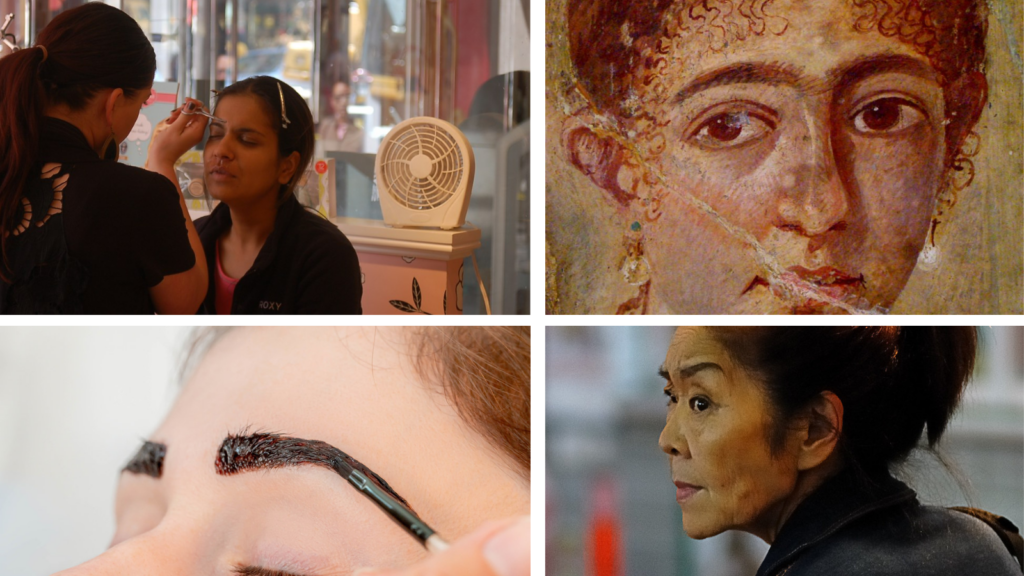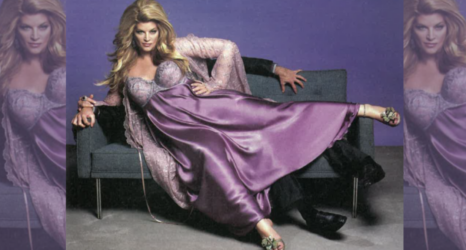
Every month, my mother would get her pot of Jolen crème bleach from under the bathroom sink and start the hour-long, burning process of bleaching her upper lip hair. When I was small, I liked to help her measure the bleach powder with the kit’s tiny measuring stick, mixing it dutifully with a few drops of water in a faux chemistry experiment. I would watch her tweeze the sides of her face, using the mirror of her lipstick case. Once she was done, she would let me poke at my own face with the wrong end of the tweezers, so I could pretend I was doing the same.
I’ve had a unibrow since I reached puberty and started getting hair on my legs. While not straight across from brow to brow, the hair that travels in a V down the bridge of my nose caused a lot of strife growing up. Middle-school me was into teen magazines like J-14 and Tiger Beat—this was the era of “Hollaback Girl” Gwen Stefani, Xtina and low-rise jeans. Over-plucking was the norm, and many then-teenagers still lack the brows to prove it.
But thin brows weren’t always on trend. In ancient Greece, the unibrow signified intelligence and beauty, and women without one would connect the gap using black kohl.
Today’s beauty standards in America tend to follow white European ideals—high cheekbones, small noses, thin bodies and a lack of hair, especially on the face. Because of this, the unibrow hasn’t typically been in fashion. Of course, there are exceptions: Frida Kahlo famously loved and embraced her unibrow, filling it in with eyebrow pencil, and today Greek-Cypriot model Sophia Hadjipanteli has made her prominent unibrow part of her signature look.
I hated my unibrow growing up. It wasn’t until I was 16 that I started to think about my hairiness differently. That same year, I came out to myself as nonbinary—and that, in turn, made me confront every one of my physical characteristics in a new way. I wanted to look feminine without being seen as a woman, and I wanted to look masculine without being mistaken for a 12-year-old boy.
I came out to myself as nonbinary—and that, in turn, made me confront every one of my physical characteristics in a new way. … Giving up was a godsend. I started to work with what was given to me.
I’ve always been petite and girlish—4’11” and round-faced. To someone who was experiencing puberty-induced gender dysphoria, these characteristics were poison. I tried fighting against my body for a while—I cut my hair short and wore the baggiest sweatshirts I could find, even though I missed putting my hair up with a pencil, and I would overheat in the summer. I was unhappy. There were parts of myself I did like, but I was torn between all the standards I wanted to achieve: the soft feminine ideal advertised to me in Tiger Beat, the skinny white masculine-leaning androgyny that was pedestaled in online nonbinary spaces, and the yearning I felt to be comfortable in my own skin.
Giving up was a godsend. I started to work with what was given to me—my natural beauty, my petiteness, the hairy Jewish genes that my mother and father passed down to me. When I was 22 and out of college, I finally started to develop my own personal style. I paired dresses with Hawaiian shirts, I got tattoos and piercings, I experimented—with hair dye, with glitter, with loose crop tops and leather jackets. I worried less about how I wanted people to see me, and more about what I wanted to see when I looked in the mirror. I thought about who my 16-year-old self wanted to be.
I’ve started to draw in my unibrow when I go out: I use brow gel and an old mascara wand, combing up the hairs that point down into my nose and darkening them with eyeshadow. It makes me look striking and androgynous and cool—and more importantly, it was my choice to keep.
Up next:
U.S. democracy is at a dangerous inflection point—from the demise of abortion rights, to a lack of pay equity and parental leave, to skyrocketing maternal mortality, and attacks on trans health. Left unchecked, these crises will lead to wider gaps in political participation and representation. For 50 years, Ms. has been forging feminist journalism—reporting, rebelling and truth-telling from the front-lines, championing the Equal Rights Amendment, and centering the stories of those most impacted. With all that’s at stake for equality, we are redoubling our commitment for the next 50 years. In turn, we need your help, Support Ms. today with a donation—any amount that is meaningful to you. For as little as $5 each month, you’ll receive the print magazine along with our e-newsletters, action alerts, and invitations to Ms. Studios events and podcasts. We are grateful for your loyalty and ferocity.





